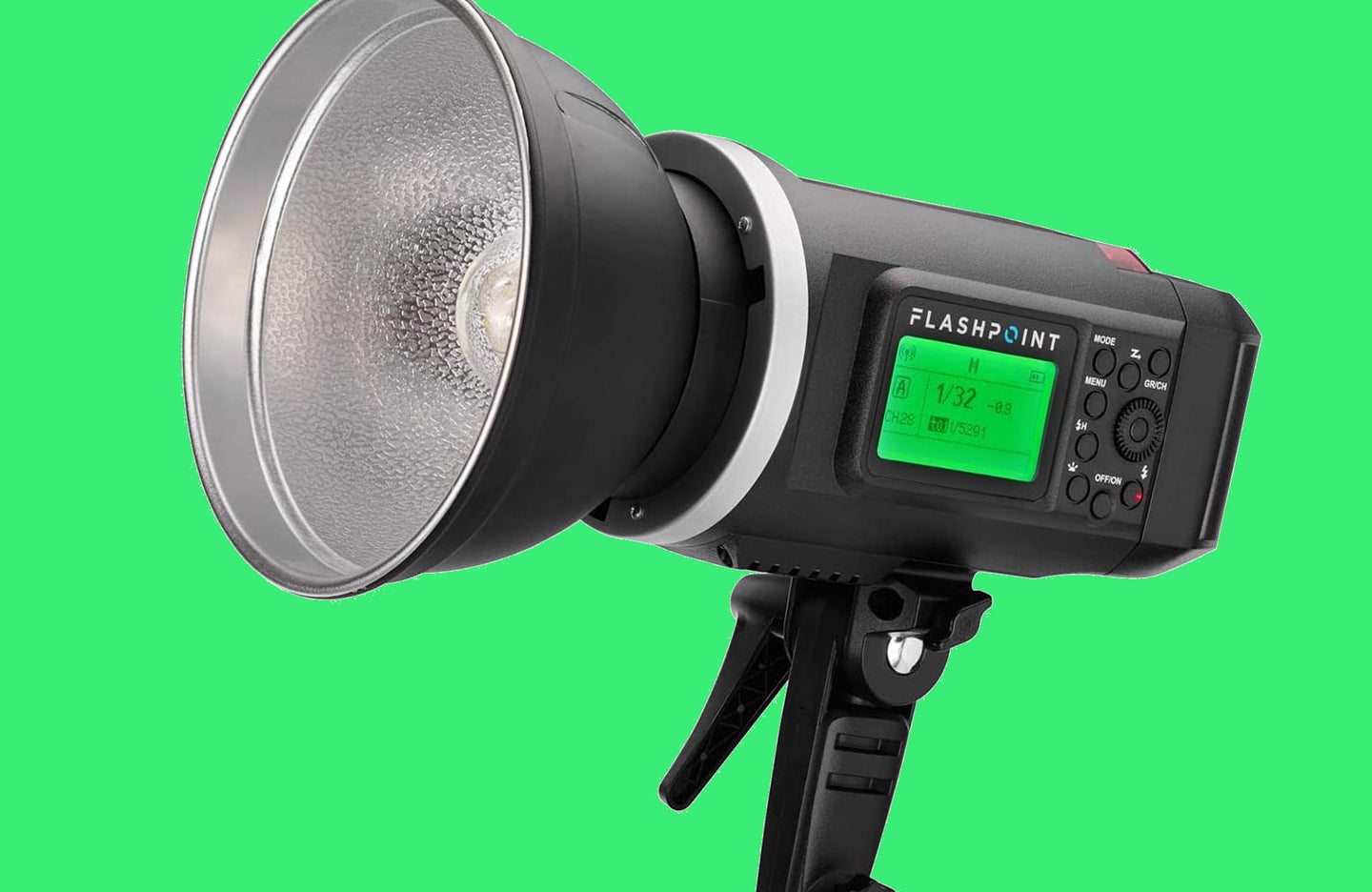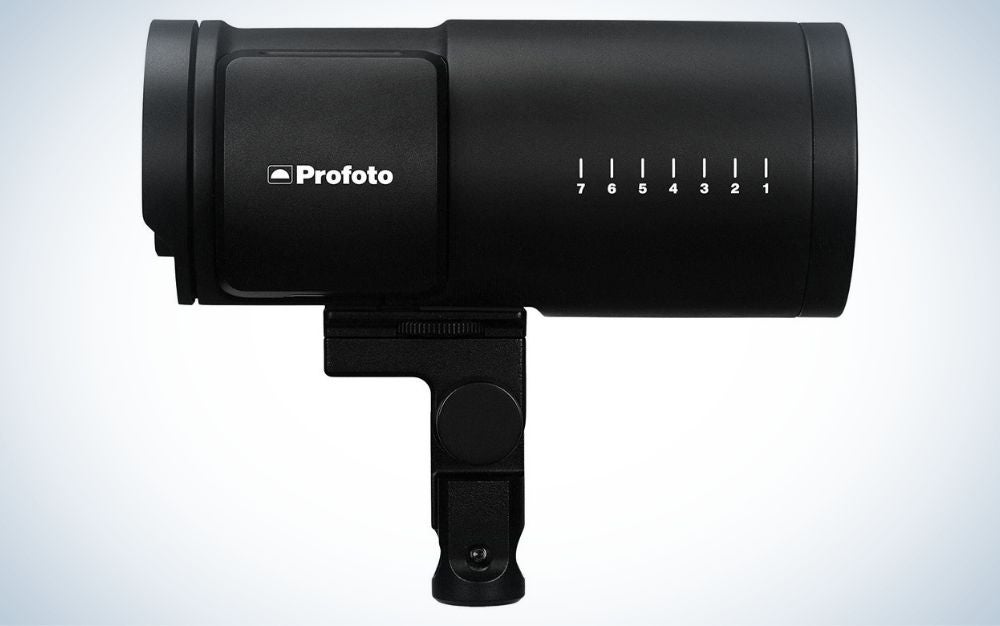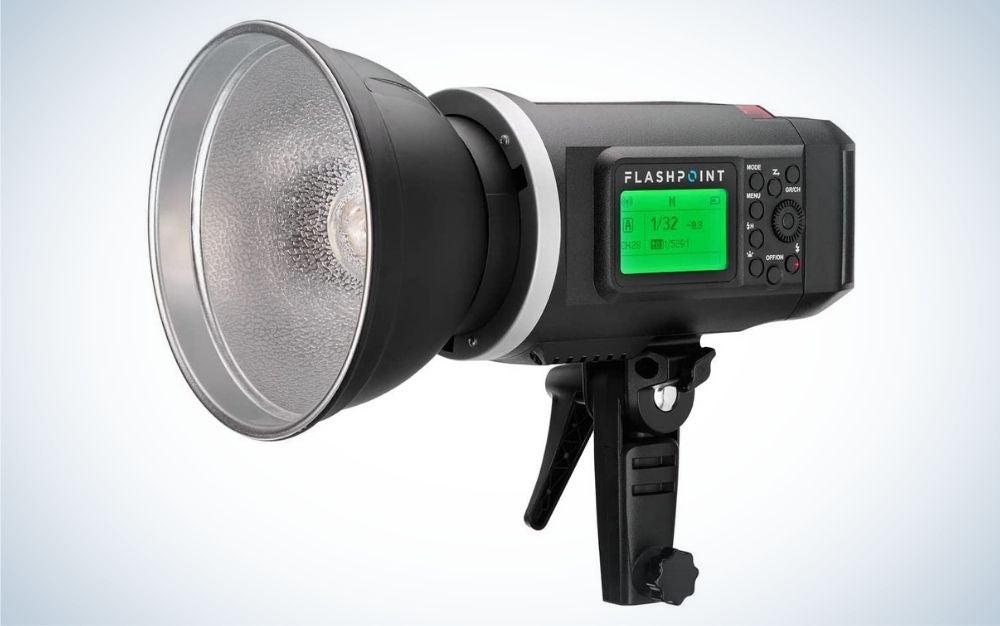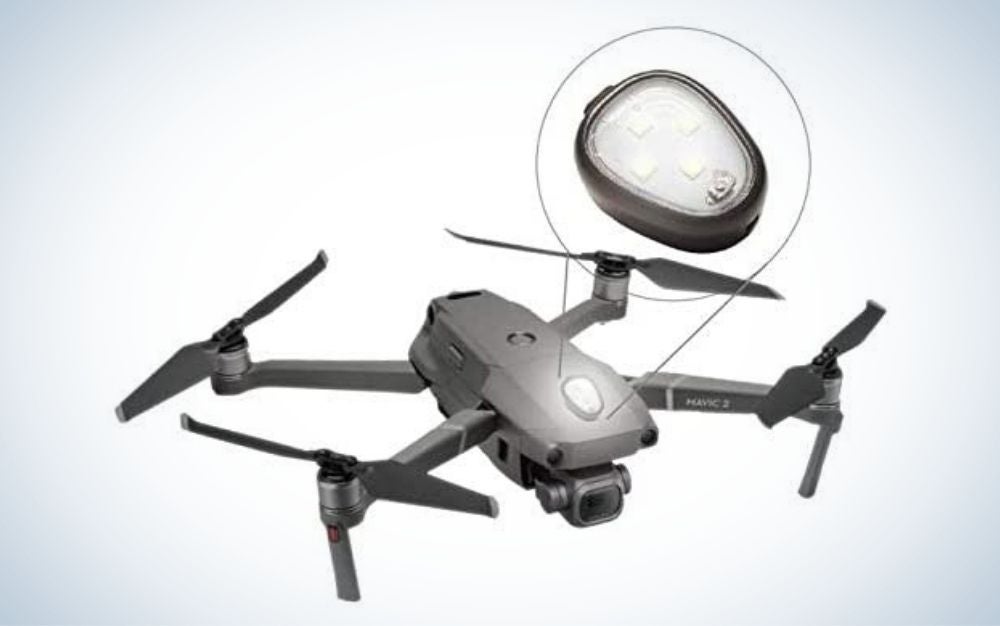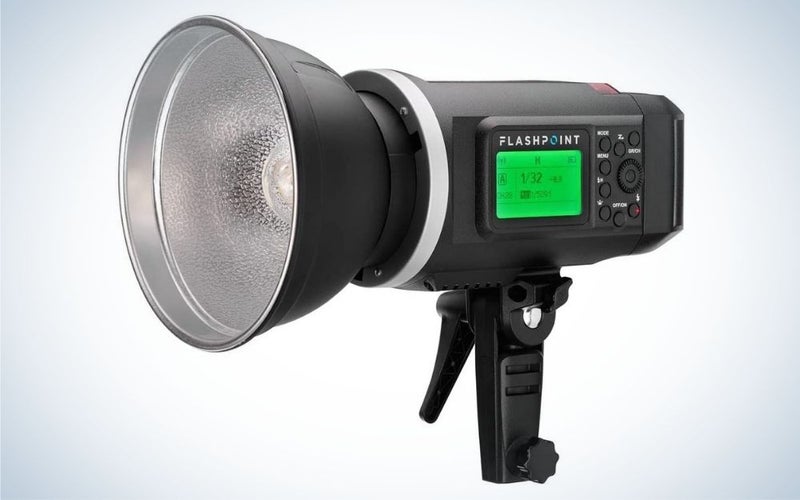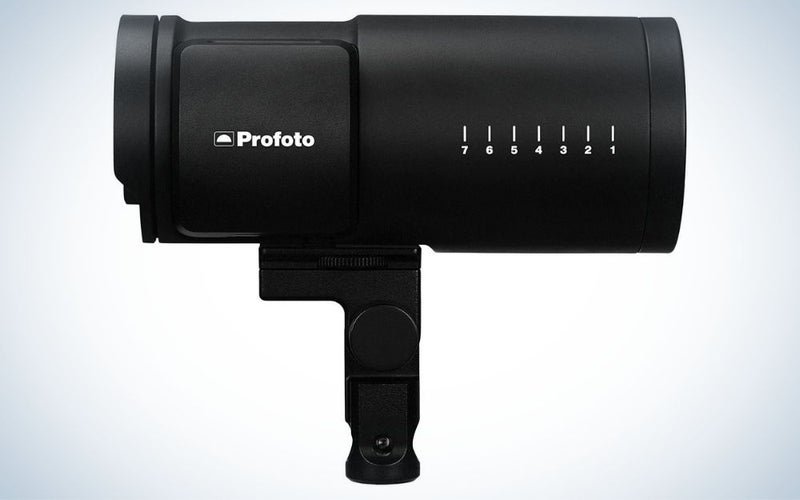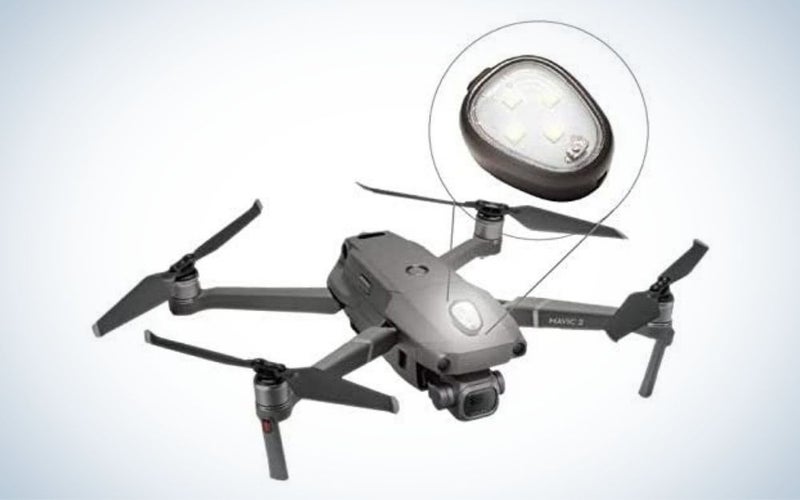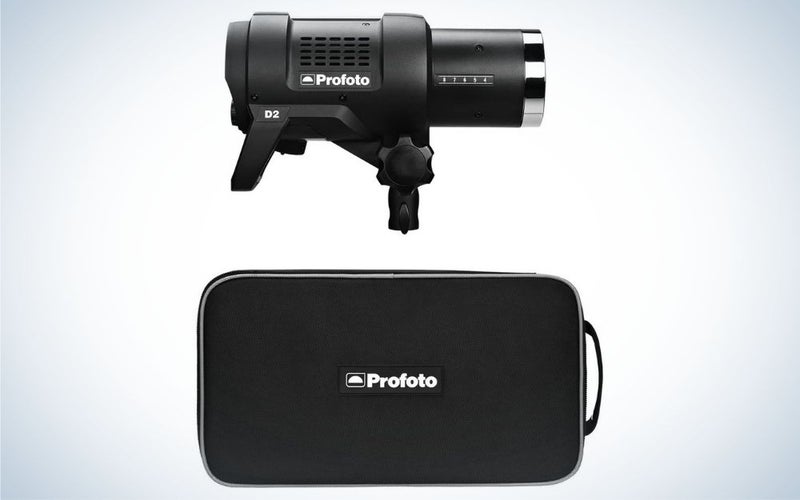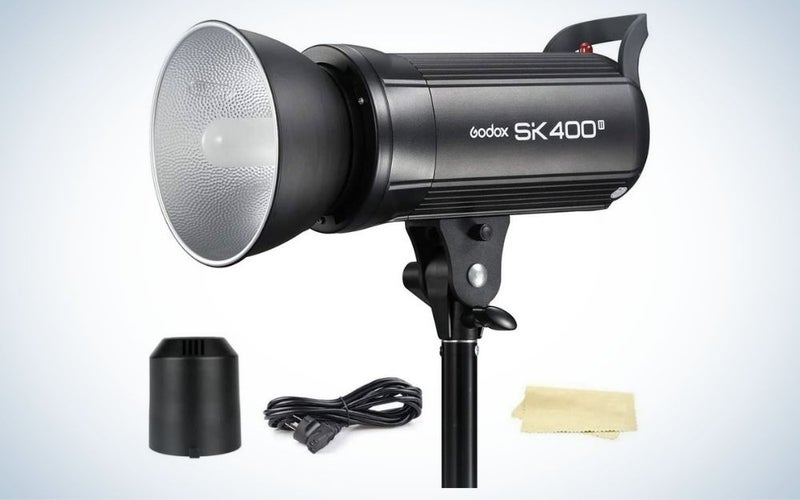We may earn revenue from the products available on this page and participate in affiliate programs. Learn more ›
The phrase “strobe lights” means something different to photographers than it does DJs or haunted house curators. Good light is as crucial a tool to photography as a nice lens and a solid camera body. It’s why photographers value early morning and pre-sunset golden-hour light so much. Strobe lights allow you to harness the power of light without having to rely on nice weather days. They give you increased creative control as a photographer. They’re useful in the studio and in the field. These are the best strobe lights for a variety of different budgets and shooting scenarios.
- Best overall: Flashpoint XPLOR 600
- Best portable: Profoto B10 Plus
- Best for drones: Lume Cube Drone Strobe
- Best for working in the studio: Profoto D2 1000Ws AirTTL Monolight
- Best budget: Godox SK400II
Things to consider when shopping for the best strobe lights
Before we get to the specific product picks, here are some essential terms and specs you should understand before jumping into the world of strobes.
Power
Output matters when it comes to lighting with strobes. Lights that put out higher amounts of flash power also tend to cost more and consume more power. Strobes run the gamut from 160-watt monolights ideal for indoor shooting scenarios to 2400-watt pack-based systems that can overpower the sun. Higher wattage gives you more oomph when you need it. Higher-output battery-powered strobes can also often fire on lower-power settings. That can actually save battery in the long run compared to a smaller light firing full blast.
TTL metering
Most of the time, shooting with a strobe is simpler if you’re in manual mode, at least once you get the hang of it. Some lights, however, offer TTL metering. That feature allows them to pull light readings from the camera itself and adjust the power to toss out the proper amount of illumination. Whether you like TTL or not is really personal preference.
Budget
The highest end strobe lights will feature high wattage outputs, advanced features like TTL and HSS, and super-fast recycle times. While buying strobes from a brand like Profoto will set you back a few thousand dollars, there are plenty of lower-cost, high-quality options from third party brands like Flashpoint and Godox. The first thing that you should consider when shopping for a strobe light is how much you have to spend. Keep in mind that in many situations the most expensive option might not be the best option for the job.
Shooting scenarios
The second most important thing to consider is where you will be using your strobe lights. If you are looking for something versatile that can be used on location without access to a power outlet, you should consider a strobe light that can be powered by a battery. A battery powered strobe will give you flexibility to shoot outdoors, but it does tend to be more expensive. If you will primarily be shooting inside a studio having battery power may not be necessary. If you are buying from a third party brand will likely lower the cost of your investment.
High-speed sync
You’ll likely see high-speed sync abbreviated with HHS. This technology helps strobes work with cameras above their maximum flash speeds. Cameras rely on a shutter that opens and closes to let light onto the film or sensor. Once the shutter speed gets fast enough, this creates an issue with allowing the flash to illuminate the entire frame. HSS allows the flash to send out light in a series of imperceptible pulses that compensate for the shutter’s fast movements. If you’re planning to shoot in scenarios that require fast shutter speeds, then this is going to be crucial. It really comes in handy if you’re trying to shoot in bright locations like out in full sun.
Best overall: Flashpoint XPLOR 600
Flashpoint
Why it made the cut: Flashpoint’s XPLOR 600 lights are a fast, reliable and affordable alternative for strobe lights that work great inside the studio or on location.
Specs
- 14.65 lbs
- HSS up to 1/80,000 sec
- 0.01-2.5 second recycle time when fully charged
Pros
- Built-in wireless receiver
- Super fast recycle times
- Affordable
- 9 steps of adjustment
Cons
- No way to adjust light temperature without gels
- Only compatible with Canon and Nikon camera systems
These mid-level monolights are an affordable, yet powerful option, making them our pick for best strobe light overall and a great place to start if you are a photographer building out a lighting kit. The XPLOR 600 lights offer 600 watts of light output, 500 full power flashes with a fast recycle time of 0.01 – 2.5 second when running on a fully charged battery.
They have built in 2.4G wireless connectivity which will allow your camera to communicate with the lights up to 80m away and sync speeds up to 1/80,000 sec. Although they’re not as compact as some monolights on the market, they do come with a sturdy carrying case with shoulder strap if you are working outside of the studio.
They’re also a fraction of the price of other battery operated monolights currently on the market.
Best portable: Profoto B10 Plus
Profoto
Why it made the cut: The extremely compact Profoto B10 Plus offers a 500 watt output and only weighs 4.2 lbs—making it an excellent choice for shoots on location or in the studio.
Specs
- 4.2 lbs
- TTL and HSS capabilities
- Recycle time of 0.05 – 2.5 seconds when fully charged
Pros
- Compact size
- Adjustable color temperature
- Compatible with wide array of Profoto accessories
Cons
- Expensive
The Profoto B10 strobes are about the size of a 70-200mm lens. That’s tiny compared to full-sized monolights that would look right at home in a studio. Despite their compact design, however, the B10 flashes boast a powerful 500-watt output. When fully charged these lights put out 200 flashes with a 0.05 – 2.5 second recycle time. They have an integrated continuous light for previewing shots, and feature adjustable color temperature too. The Profoto B10s are compatible with all of Profotos light shaping tools, making them a great option for shooting on location outdoors, or inside the controlled environment of the studio. These aren’t cheap, but they’re some of the most versatile and robust strobes you can buy right now.
Best for drones: Lume Cube Drone Strobe
Lume Cube
Why it made the cut: This anti-collision drone light is compatible with every drone on the market, meets FAA requirements and offers 3+ miles of visibility—making it the safest way to take flight with your drone.
Specs
- Compact 1.5” size
- Compatible with any drone
- Features three different lighting modes
Pros
- Affordable
- Bright white, red or green lighting options
- Can be used as a slow flash, fast flash or continuous light
Cons
- Adding the light makes fitting a drone in its case a tight squeeze
- On/Off switch is easy to hit accidentally, leading to unintentional battery drain
Lume Cube’s Drone Strobe works a little differently than the other strobe lighting systems in this guide. Rather than being used as a way to light your subjects for shooting, the drone strobe is a tool that will increase your drone’s visibility during twilight flights.
The strobe is compatible with all types of drones and attaches via a 3M adhesive mount to the top of the craft for safe flying. By default the light is a bright white, but comes with accessory caps to change the color to red or green. The light can be set to flash quickly, slowly or as a continuous light. It’s charged via USB, has a battery life of 6 hours and is visible up to 3 miles away. If you are looking to take your drone out for a spin during sunset to capture some aerial views, this powerful little light will help ensure that you are flying as safely as possible.
Best for working in the studio: Profoto D2 1000Ws AirTTL Monolight
Profoto
Why it made the cut: Profoto’s flagship monolight offers a light output of 1000 watts, extremely fast recycle times and 10 stops of control.
Specs
- 11.66 lbs
- TTL and HSS capabilities
- 0.03 – 1.2 second recycle time when fully charged
Pros
- 1000 watt output
- 10 steps of adjustment
- Fast recycle times
Cons
- Expensive
- Not battery powered
The Profoto 1000W AirTTL Monolights are an extremely powerful choice for working inside the studio. These lights have TTL and HSS capabilities, offer 1000 watts of power output and 10 stops of control—making them a versatile tool for a variety of styles of photography.
They have faster recycle times than the other lights in this buying guide because they draw power from an outlet rather than a battery. With HSS enabled, they can sync at up to 1/8000 sec and can be used in conjunction with other Profoto lighting tools. Beyond the specs on paper, Profoto has an impeccable reputation for build quality and overall light quality. These are an investment, though, so keep in mind that they will occasionally need new bulbs or perhaps other services to keep them running forever. Take good care of them, though, and they will produce incredible quality light for a very long time.
Best budget: Godox SK400II
Godox
Why it made the cut: This low-cost strobe light offers 400 watts of output and a built-in wireless system for communicating with your camera for a very cheap price.
Specs
- 8.33 lbs
- 2.4G wireless system
- 400 watt output
Pros
- Budget-friendly
- Adjustable modeling lamp
- Easy to use LCD panel
Cons
- Not battery powered
- No HSS or TTL
The Godox SK400II offers 400 watts of power output, an 150 watt adjustable modeling lamp and a 2.4G wireless system to communicate with your camera. A clear, easy-to-read LCD panel on the back of the strobe lets you make adjustments to power output between 1/16-1/1. Although this light lacks features like TTL and HSS—meaning you will have to control power output manually, at just over $100 it’s one of the most affordable monolights on the market. This is a great choice for shooting ecommerce, simple portraits or products in a studio setting.
This is the kind of strobe that’s great for beginners because it doesn’t overload them with options and features. Plus, it forces shooters to use manual mode, which will help them learn better flash technique that will serve them well down the road.
FAQs
Q: What features should I consider when selecting a strobe light?
When purchasing a strobe light for photography you should consider things like budget, output wattage, if it’s battery powered, and if it’s compatible with TTL—meaning it can communicate with your camera and adjust its intensity based on your camera’s setting. Strobe lights come in a wide variety of price ranges, although generally speaking lights that have higher wattage output capabilities, can be powered without being plugged into an outlet and have features like TTL or WiFi, will be more expensive than strobe lights that don’t have these features.
Q: What makes a speedlight different from a strobe light?
A strobe light has a faster recycle time than a speedlight, often comes with features such as a modeling light, and generally has a higher wattage of light output. They are also typically bigger. A speedlight, also commonly known as an on-camera flash, is lighter and more portable but can be used to imitate the effects of a higher-end strobe light.
Q: Is a strobe light better than continuous lighting?
Continuous lights and strobe lights are two different styles of lighting and what one is better often comes down to the subject matter, the intended vibe from the shoot, and personal preferences of the photographer. A strobe light will give you a more powerful light source compared to a continuous light source and are great for creating moody lighting. Continuous lights are better for capturing a subject in nice even light or when shooting video. Strobes can also freeze action thanks to their very short durations.
Q: How many strobe lights should I buy?
How many strobe lights you should buy is entirely dependent on budget. On high-end shoots it’s not uncommon for a photographer to be using three or more strobes on set, but you can easily replicate the classic three point lighting setup with a single strobe, and two speedlights with radio triggers. The most important thing is that your lights will be able to communicate with one another and your camera.
Q: What is the difference between a strobe and a flash?
A strobe light is a flash that can happen rapidly over and over again, strobe lights get their name because of their fast recycle times and their ability to continuously emit light while you are shooting. A flash is a single burst of light and another name for a speedlight. Although these two tools can create similar looking work, a strobe is a more high powered and less portable version of a flash or a speedlight.
Methodology for choosing the best strobe lights
When selecting the items that are in this buying guide we looked at strobe lights that fit a variety of budgets and shooting scenarios. It was important to pick lights that fell into the high-end, mid-range and budget categories. It was also important to include a mixture of strobes that could be used outside of the studio (battery powered options) as well as strobes that needed to be plugged in.
The items that appear in this buying guide were selected through a mixture of personal use, editorial reviews, and user feedback. We use several of these products on a very regular basis for personal and professional work.
Final thoughts on the best strobe lights
When shopping for a strobe, it’s important to consider what you will be shooting, where you will be shooting, how much light you will need, and what your budget looks like. The highest end Profoto light might not be the best light for you if you intend to shoot a lot on location, rather than in the studio. Ultimately, choosing a strobe light has as much to do with personal preference and shooting style as it does with budget.
